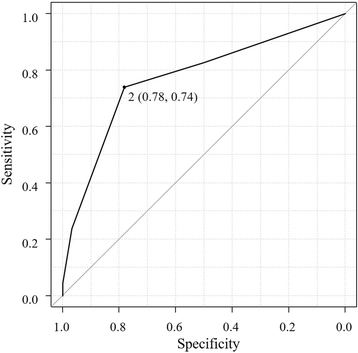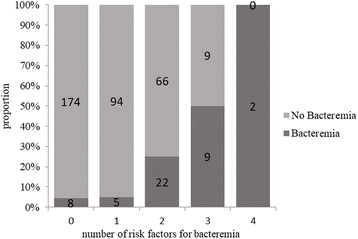A model for predicting bacteremia in patients with community-acquired pneumococcal pneumonia: a retrospective observational study
- PMID: 29382316
- PMCID: PMC5791379
- DOI: 10.1186/s12890-018-0572-1
A model for predicting bacteremia in patients with community-acquired pneumococcal pneumonia: a retrospective observational study
Abstract
Background: Pneumococcal pneumonia causes high morbidity and mortality among adults. This study aimed to identify risk factors for bacteremic pneumococcal pneumonia, and to construct a prediction model for the development of bacteremia in patients with community-acquired pneumococcal pneumonia.
Methods: We retrospectively analyzed data from patients hospitalized with community-acquired pneumococcal pneumonia between April 2007 and August 2015. Logistic regression models were applied to detect risk factors for pneumococcal bacteremia, and a receiver operating characteristic curve was used to devise a prediction model.
Results: Based on the results of sputum cultures, urine antigen tests, and/or blood cultures, 389 patients were diagnosed with pneumococcal pneumonia, 46 of whom had bacteremia. In the multivariate analysis, age < 65 years, serum albumin level < 3.0 g/dL, need for intensive respiratory or vasopressor support (IRVS), and C-reactive protein level > 20 mg/dL were identified as independent risk factors for the development of pneumococcal bacteremia. The bacteremia prediction score based on receiver operating characteristic curve analysis had a sensitivity of 0.74 and a specificity of 0.78 in patients with two risk factors. The area under the receiver operating characteristic curve was 0.77 (95% confidence interval (CI), 0.70-0.85).
Conclusions: Age < 65 years, hypoalbuminemia, IRVS, and high C-reactive protein level on admission are independent risk factors for the development of bacteremia in patients with community-acquired pneumococcal pneumonia. A prediction model based on these four risk factors could help to identify patients with community-acquired pneumococcal pneumonia at high risk of developing bacteremia; this can be used to guide antibiotic choices.
Trial registration: UMIN-CTR UMIN 000004353 . Registered 7 October 2010. Retrospectively registered.
Keywords: Bacteremia; Blood culture; Community-acquired pneumonia; Pneumococcal pneumonia.
Conflict of interest statement
Ethics approval and consent to participate
This study was approved by the institutional review board of Kurashiki Central Hospital (approval number 2235). All patients provided informed consent to participate in this study.
Consent for publication
Not applicable.
Competing interests
TI has received honoraria from Pfizer, Japan, Inc. The other authors declare that they have no competing interests.
Publisher’s Note
Springer Nature remains neutral with regard to jurisdictional claims in published maps and institutional affiliations.
Figures


Similar articles
-
Can we predict pneumococcal bacteremia in patients with severe community-acquired pneumonia?J Crit Care. 2013 Dec;28(6):970-4. doi: 10.1016/j.jcrc.2013.04.016. J Crit Care. 2013. PMID: 24216331
-
Rate and Predictors of Bacteremia in Afebrile Community-Acquired Pneumonia.Chest. 2020 Mar;157(3):529-539. doi: 10.1016/j.chest.2019.10.006. Epub 2019 Oct 26. Chest. 2020. PMID: 31669433
-
Invasive Disease vs Urinary Antigen-Confirmed Pneumococcal Community-Acquired Pneumonia.Chest. 2017 Jun;151(6):1311-1319. doi: 10.1016/j.chest.2017.01.005. Epub 2017 Jan 16. Chest. 2017. PMID: 28093269
-
Burden of pneumococcal community-acquired pneumonia in adults across Europe: A literature review.Respir Med. 2018 Apr;137:6-13. doi: 10.1016/j.rmed.2018.02.007. Epub 2018 Feb 19. Respir Med. 2018. PMID: 29605214 Review.
-
Pneumococcal vaccine in the prevention of community-acquired pneumonia: a skeptical view of cost-effectiveness.Semin Respir Infect. 1993 Dec;8(4):294-9. Semin Respir Infect. 1993. PMID: 7938926 Review.
Cited by
-
Biomarkers for Lipid and Albumin Metabolism in Hospitalized Patients with Underlying Diseases and Community-Acquired Pneumonia Caused by Bacterial or SARS-CoV-2 Infection.J Inflamm Res. 2023 Mar 15;16:1135-1145. doi: 10.2147/JIR.S399921. eCollection 2023. J Inflamm Res. 2023. PMID: 36945318 Free PMC article.
-
Age, Pulse, Urea and Albumin (APUA) Model: A Tool for Predicting in-Hospital Mortality of Community-Acquired Pneumonia Adapted for Patients with Type 2 Diabetes.Diabetes Metab Syndr Obes. 2020 Oct 9;13:3617-3626. doi: 10.2147/DMSO.S268679. eCollection 2020. Diabetes Metab Syndr Obes. 2020. PMID: 33116713 Free PMC article.
-
Hypoalbuminemia as Surrogate and Culprit of Infections.Int J Mol Sci. 2021 Apr 26;22(9):4496. doi: 10.3390/ijms22094496. Int J Mol Sci. 2021. PMID: 33925831 Free PMC article. Review.
-
A Simple Bacteremia Score for Predicting Bacteremia in Patients with Suspected Infection in the Emergency Department: A Cohort Study.J Pers Med. 2023 Dec 30;14(1):57. doi: 10.3390/jpm14010057. J Pers Med. 2023. PMID: 38248758 Free PMC article.
-
Burden of pneumococcal disease among adults in Southern Europe (Spain, Portugal, Italy, and Greece): a systematic review and meta-analysis.Hum Vaccin Immunother. 2021 Oct 3;17(10):3670-3686. doi: 10.1080/21645515.2021.1923348. Epub 2021 Jun 9. Hum Vaccin Immunother. 2021. PMID: 34106040 Free PMC article.
References
-
- Ardanuy C, Tubau F, Pallares R, Calatayud L, Dominguez MA, Rolo D, et al. Epidemiology of invasive pneumococcal disease among adult patients in barcelona before and after pediatric 7-valent pneumococcal conjugate vaccine introduction, 1997-2007. Clin Infect Dis. 2009;48:57–64. doi: 10.1086/594125. - DOI - PubMed
-
- Roson B, Carratala J, Dorca J, Casanova A, Manresa F, Gudiol F. Etiology, reasons for hospitalization, risk classes, and outcomes of community-acquired pneumonia in patients hospitalized on the basis of conventional admission criteria. Clin Infect Dis. 2001;33:158–165. doi: 10.1086/321808. - DOI - PubMed
-
- van der Eerden MM, Vlaspolder F, de Graaff CS, Groot T, Bronsveld W, Jansen HM, et al. Comparison between pathogen directed antibiotic treatment and empirical broad spectrum antibiotic treatment in patients with community acquired pneumonia: a prospective randomised study. Thorax. 2005;60:672–678. doi: 10.1136/thx.2004.030411. - DOI - PMC - PubMed
Publication types
MeSH terms
Substances
LinkOut - more resources
Full Text Sources
Other Literature Sources
Research Materials
Miscellaneous

